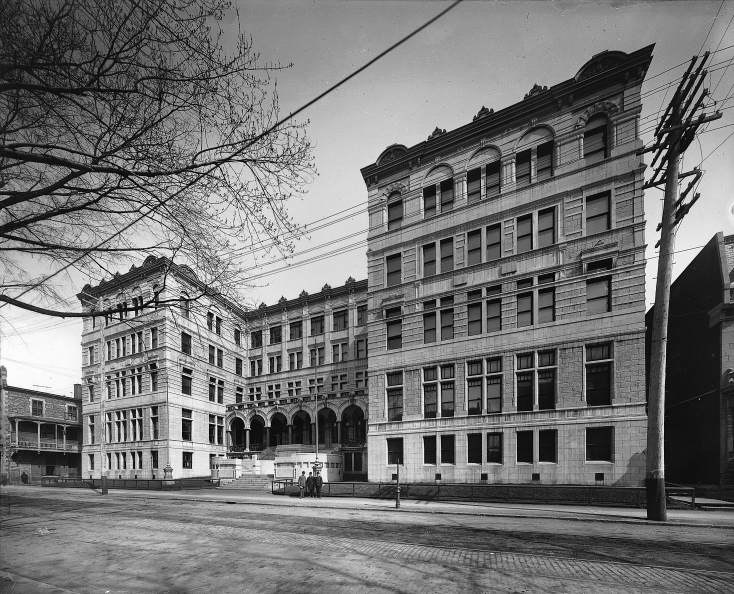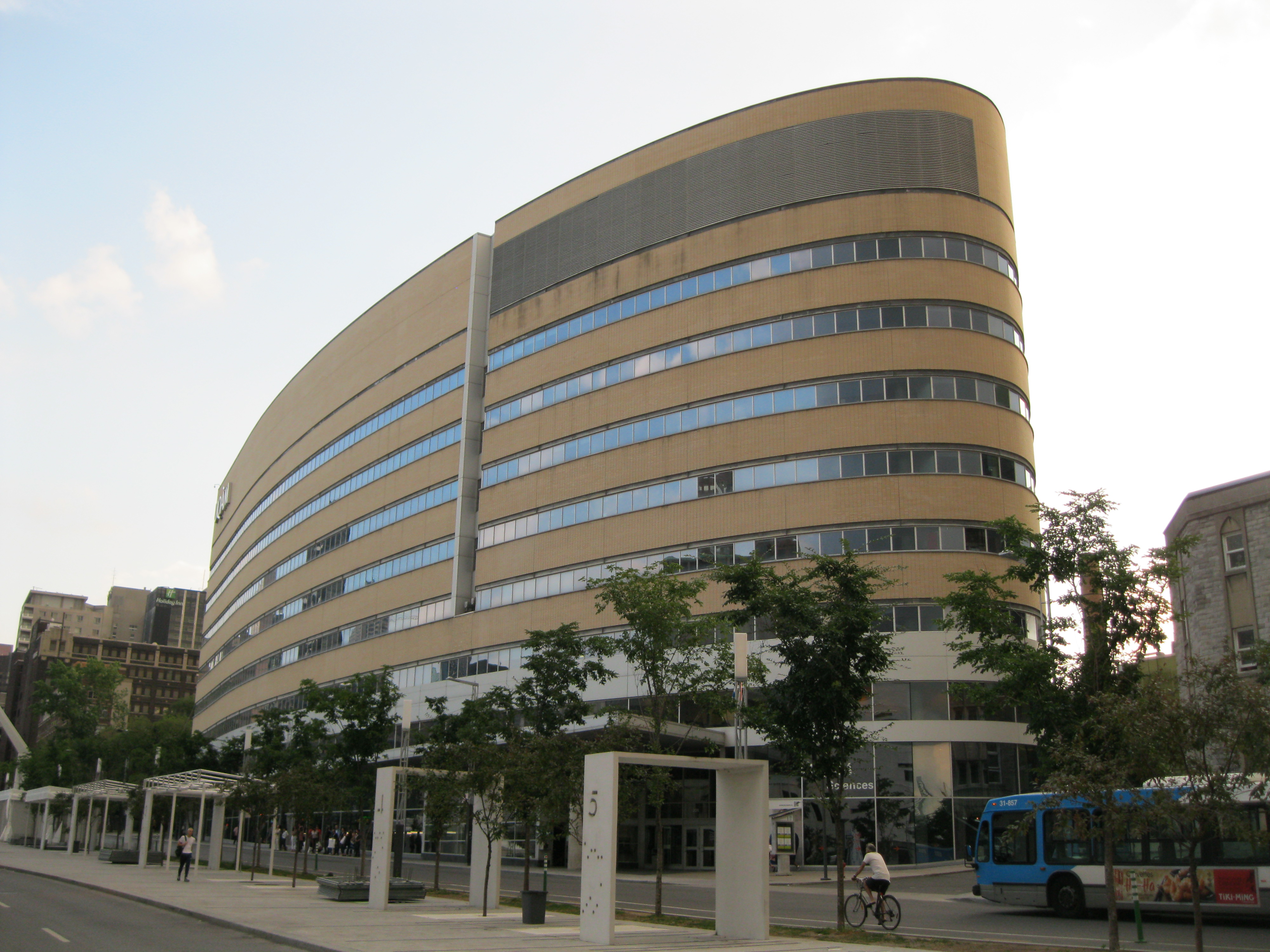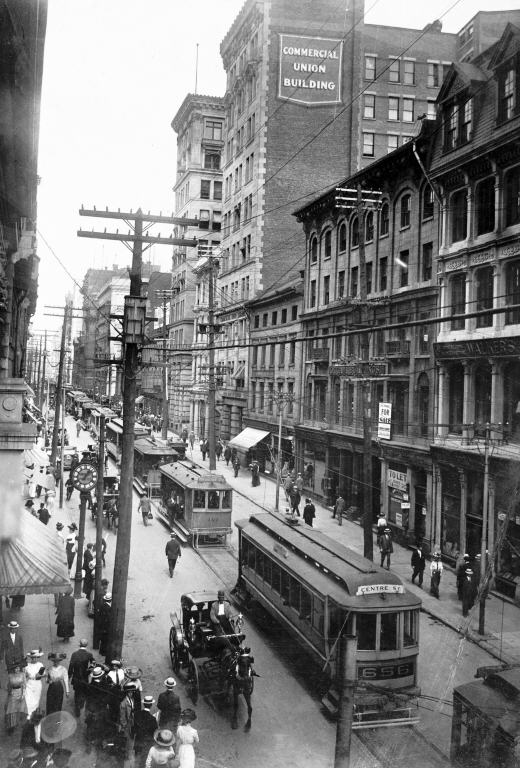|
Saint-Denis Street
Saint Denis Street (officially in french: Rue Saint-Denis) is a major north–south thoroughfare in Montreal, Quebec. It extends from the Notre-Dame-de-Bon-Secours Chapel on Saint Paul Street in Old Montreal to the bank of the Rivière des Prairies at the north end of the island. It is designated Route 335 from Sherbrooke Street to the Metropolitan Expressway, and is known as Bonsecours Street south of Saint Antoine Street. Along its length, it passes through the boroughs of Ville-Marie, Le Plateau-Mont-Royal, Rosemont–La Petite-Patrie, Villeray–Saint-Michel–Parc-Extension, and Ahuntsic-Cartierville. Saint-Denis serves as one of the primary thoroughfares of both the Latin Quarter, where it plays host to a number of bars and restaurants, to the Plateau Mont-Royal, where it is known as one of the best places to view Montreal's distinct style of architecture. It becomes primarily a residential street north of the Metropolitan Expressway. Sauvé train station is located o ... [...More Info...] [...Related Items...] OR: [Wikipedia] [Google] [Baidu] |
Quartier Latin, Montreal
The Quartier Latin is an area in the Ville-Marie (borough), Ville-Marie borough of Montreal, located east of the Quartier des Spectacles and west of the Centre-Sud and Gay Village, Montreal, Village, centred around UQAM and lower Saint-Denis Street. It is known for its theatres, artistic atmosphere, cafés, and boutiques. It owes its name, a reference to the Quartier Latin in Paris, to the presence of the École Polytechnique de Montréal and the nascent Université de Montréal in the 1920s. In the 1940s the university moved out and headed for a new campus on the north slopes of Mount Royal, far from the downtown borough. In the late 1960s Université du Québec à Montréal, UQAM was born and established itself in the Ville-Marie borough, giving a modern underpinning to the name. A large junior college, the CEGEP Cégep du Vieux Montréal, du Vieux-Montreal also moved in at about the same period. The Grande Bibliothèque du Québec was opened in the area in 2005, joining the ... [...More Info...] [...Related Items...] OR: [Wikipedia] [Google] [Baidu] |
Villeray–Saint-Michel–Parc-Extension
Villeray–Saint-Michel–Parc-Extension is a borough (''arrondissement'') in the city of Montreal, Quebec. It had a population of 143,853 according to the 2016 Census and a land area of . The borough of Villeray–Saint-Michel–Parc-Extension was created on January 1, 2002, following the municipal reorganization of Montreal. The borough includes the neighbourhoods of Villeray, Saint-Michel, and Parc-Extension. History Until the late Nineteenth century, the area that today comprises the borough of Villeray–Saint-Michel–Parc-Extension was predominantly rural and dotted with farms. The inauguration of the Canadian Pacific Railway in 1878 and the arrival of electric streetcars in 1892 permitted the growth of Villeray. It was also in this era that the Italian immigrant community chose the neighbourhood as their preferred location. In the early Twentieth century, Park Extension became industrialized, and a dozen quarries opened which led to the economic development of the are ... [...More Info...] [...Related Items...] OR: [Wikipedia] [Google] [Baidu] |
Cégep Du Vieux Montréal
Cégep du Vieux Montréal is a CEGEP (Collège d'enseignement général et professionnel, or College of General and Vocational Education) located at 255 Ontario Street East, in Montreal, Quebec, Canada. The College of General and Vocational Education is affiliated with the ACCC and CCAA. History In 1967, several institutions were merged and became public, when the Quebec system of CEGEPs was created. Established in 1968, it was composed of five distinct pavilions. Since 1976, it has been regrouped into a single, 11-story building, but with three secondary pavilions. Programs The CEGEP offers two types of programs: pre-university and technical. The pre-university programs, which take two years to complete, cover the subject matter which roughly corresponds to the additional year of high school given elsewhere in Canada in preparation for a chosen field in university, as well as an introductory specialization that generally happens in freshman year. The technical programs, wh ... [...More Info...] [...Related Items...] OR: [Wikipedia] [Google] [Baidu] |
Université Du Québec à Montréal
The Université du Québec à Montréal (English: University of Quebec in Montreal), also known as UQAM, is a French-language public university based in Montreal, Quebec, Canada. It is the largest constituent element of the Université du Québec system. UQAM was founded on April 9, 1969, by the government of Quebec, through the merger of the École des beaux-arts de Montréal, a fine arts school; the Collège Sainte-Marie, a classical college; and a number of smaller schools. Although part of the UQ network, UQAM possesses a relative independence which allows it to print its own diplomas and choose its rector. In the fall of 2018, the university welcomed some 40,738 students, including 3,859 international students from 95 countries, in a total of 310 distinct programs of study, managed by six faculties (Arts, Education, Communication, Political Science and Law, Science and Social science) and one school (Management). It offers Bachelors, Masters, and Doctoral degrees. It is ... [...More Info...] [...Related Items...] OR: [Wikipedia] [Google] [Baidu] |
Saint Catherine Street
Sainte-Catherine Street (french: rue Sainte-Catherine) () is the primary commercial artery of Downtown Montreal, Quebec, Canada. It crosses the central business district from west to east, beginning at the corner of Claremont Avenue and de Maisonneuve Boulevard in Westmount, and ending at the Grace Dart Extended Care Centre by Assomption metro station, where it folds back into Notre-Dame Street. It also traverses Ville-Marie, passing just east of Viau in Mercier–Hochelaga-Maisonneuve. The street is 11.2 km long, and considered the ''backbone of Downtown Montreal.'' A series of interconnected office tower basements and shopping complexes line the street, parallel to the largest segments of Montreal's underground city. Educational institutions located on or near the street include Concordia University, McGill University, Université du Québec à Montréal, Dawson College and LaSalle College. Nine metro stations serve as access to Sainte-Catherine Street, whereby it ... [...More Info...] [...Related Items...] OR: [Wikipedia] [Google] [Baidu] |
Ville-Marie Expressway
Route 136 (R-136), formerly Autoroute 720, known as the Ville-Marie Expressway (English) or Autoroute Ville-Marie (French) is an Autoroute highway in the Canadian province of Quebec that is a spur route of Autoroute 20 in Montreal. Its western terminus is located at the Turcot Interchange, a junction with Autoroute 15 and Autoroute 20, and its eastern terminus is near the Jacques Cartier Bridge ( Route 134), where the highway merges with Notre-Dame Street. The Autoroute Ville-Marie designation is named after the downtown borough of Ville-Marie, through which the expressway is routed. It was designated Autoroute 720 until 2021 when it was renamed to Route 136. Part of R-136 runs underground (below grade) through Downtown Montreal. This section begins from the west at Rue Guy (exit 4: Rue de la Montagne / Rue Atwater) and remains underground almost all the way to its eastern end, except for a short section between Rue Saint-Urbain and Rue Hôtel-de-Ville. The tunnelled se ... [...More Info...] [...Related Items...] OR: [Wikipedia] [Google] [Baidu] |
Saint Denis Of Paris
Denis of Paris was a 3rd-century Christian martyr and saint. According to his hagiographies, he was bishop of Paris (then Lutetia) in the third century and, together with his companions Rusticus and Eleutherius, was martyred for his faith by decapitation. Some accounts placed this during Domitian's persecution and incorrectly identified StDenis of Paris with the Areopagite who was converted by Paul the Apostle and who served as the first bishop of Athens. Assuming Denis's historicity, it is now considered more likely that he suffered under the persecution of the emperor Decius shortly after AD250. Denis is the most famous cephalophore in Christian legend, with a popular story claiming that the decapitated bishop picked up his head and walked several miles while preaching a sermon on repentance. He is venerated in the Catholic Church as the patron saint of France and Paris and is accounted one of the Fourteen Holy Helpers. A chapel was raised at the site of his burial by a l ... [...More Info...] [...Related Items...] OR: [Wikipedia] [Google] [Baidu] |
Rosemont Station (Montreal Metro)
Rosemont station is a Montreal Metro station in the borough of Rosemont–La Petite-Patrie in Montreal, Quebec, Canada. It is operated by the Société de transport de Montréal (STM) and serves the Orange Line. The station opened on October 14, 1966, as part of the original network of the Metro. Overview The station, designed by Duplessis, Labelle et Derome, is a normal side platform station built into a tunnel. It has a ticket barrier at transept level that leads to a single entrance, adjacent to a bus loop and to a municipal parking lot. In 2015, work began to make the station accessible at a cost of around $10m. This work was completed in January 2017, following the installation of three elevators. The OMHM is building a complex on top of the metro as well a public square on the behalf of the city of Montréal. Origin of the name This station is named for boulevard Rosemont, the main street of the Rosemont district. This area was developed on an area purchased by land spe ... [...More Info...] [...Related Items...] OR: [Wikipedia] [Google] [Baidu] |
Berri–UQAM Station
Berri–UQAM station is a Montreal Metro station in the borough of Ville-Marie, in Montreal, Quebec, Canada. It is operated by the Société de transport de Montréal (STM) and is the system's central station. This station is served by the Green, Orange, and Yellow lines. It is located in the Quartier Latin. Berri–UQAM is the 2nd deepest station in the network, and also the busiest station in the network, transfers not included. If transfers were included, the 13 million passengers number would rise to about 35–40 million a year. It is the only subway station in Canada to have three lines serving it. History The station opened as Berri-de-Montigny with the opening of the Metro on October 14, 1966, serving the Green and Orange lines. The station was the site of the inauguration of the Metro by Mayor of Montreal Jean Drapeau, president of the Commission de transport de Montréal Lucien L'Allier and Archbishop of Montreal Paul-Émile Léger. A plaque commemorating the inaugu ... [...More Info...] [...Related Items...] OR: [Wikipedia] [Google] [Baidu] |
Line 2 Orange (Montreal Metro)
The Orange Line (french: Ligne orange) is the longest and first-planned of the four subway lines of the Montreal Metro in Montreal, Quebec, Canada. It formed part of the initial network, and was extended from 1980 to 1986. On April 28, 2007, three new stations in Laval opened making it the second line to leave Montreal Island. The Orange Line measures in length and counts 31 stations. It is the longest subway line in Montreal and the second-longest in Canada after the Line 1 Yonge–University of the Toronto subway. Like the rest of the Metro network, it is entirely underground. The line runs in a U-shape from Côte-Vertu in western Montreal to Montmorency in Laval, northwest of Montreal. History The line was planned to run between Crémazie and Place-d'Armes. Work on the Orange Line began on May 23, 1962 on Berri Street just south of Jarry Street. In November 1962, the city of Montreal learned that it had been awarded the 1967 International and Universal Exposition (commo ... [...More Info...] [...Related Items...] OR: [Wikipedia] [Google] [Baidu] |
Montreal Metro
The Montreal Metro (french: Métro de Montréal) is a rubber-tired underground rapid transit system serving Greater Montreal, Quebec, Canada. The metro, operated by the Société de transport de Montréal (STM), was inaugurated on October 14, 1966, during the tenure of Mayor Jean Drapeau. It has expanded since its opening from 22 stations on two lines to 68 stations on four lines totalling in length, serving the north, east and centre of the Island of Montreal with connections to Longueuil, via the Yellow Line, and Laval, via the Orange Line. The Montreal Metro is Canada's second busiest rapid transit system and North America's fourth busiest rapid transit system, behind the New York City Subway, the Mexico City Metro and the Toronto subway, delivering an average of daily unlinked passenger trips per weekday as of . In , trips on the Metro were completed. According to the STM, the Metro system had transported over 7 billion passengers as of 2010. With the Metro and t ... [...More Info...] [...Related Items...] OR: [Wikipedia] [Google] [Baidu] |
Sauvé Station
Sauvé station is an intermodal transit station in the borough of Ahuntsic-Cartierville in Montreal, Quebec, Canada. The Montreal Metro station is operated by the Société de transport de Montréal (STM) and serves the Orange Line. It is located in the Ahuntsic district. The station opened October 14, 1966, as part of the original network of the Metro. Just south of the station on Berri Street, is the Canadian National railway line, which carries the Réseau de transport métropolitain's (RTM) Mascouche commuter and Via Rail intercity trains. The Sauvé commuter rail station is connected to these corridors, and replaces the nearby Via Rail Ahuntsic station. Overview The Metro station, designed by Adalbert Niklewicz, is a normal side platform station, built in tunnel. A single mezzanine connects entrances on either side of Sauvé Street. Origin of the name This station is named for Sauvé Street, named in 1912 for a landowner whose property the street crossed. Commu ... [...More Info...] [...Related Items...] OR: [Wikipedia] [Google] [Baidu] |






